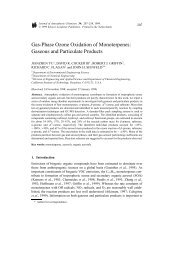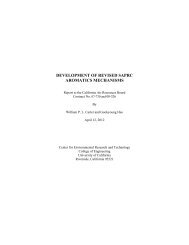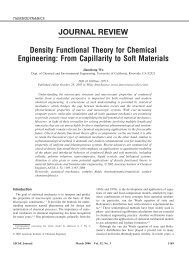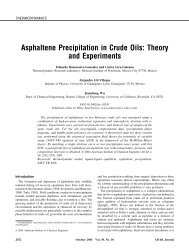Development of electroplated magnetic materials for MEMS
Development of electroplated magnetic materials for MEMS
Development of electroplated magnetic materials for MEMS
Create successful ePaper yourself
Turn your PDF publications into a flip-book with our unique Google optimized e-Paper software.
ARTICLE IN PRESS<br />
190<br />
N.V. Myung et al. / Journal <strong>of</strong> Magnetism and Magnetic Materials 265 (2003) 189–198<br />
electrodeposition and electroless deposition are<br />
well-suited to fulfill the requirements <strong>of</strong> high yield<br />
and cost effective processes. Electrochemical processes<br />
have many advantages, including precisely<br />
controlled near room temperature operation, lowenergy<br />
requirements, rapid deposition rates, capability<br />
to handle complex geometries, low cost,<br />
and simple scale-up with easily maintained equipment.<br />
In addition, the properties <strong>of</strong> <strong>materials</strong> can<br />
be ‘‘tailored’’ by controlling solution compositions<br />
and deposition parameters. Due to these advantages,<br />
<strong>electroplated</strong> s<strong>of</strong>t <strong>magnetic</strong> <strong>materials</strong> such as<br />
NiFe and CoNiFe have been widely used as<br />
recording head <strong>materials</strong> <strong>for</strong> computer hard drive<br />
industries [7]. In the case <strong>of</strong> <strong>magnetic</strong>-<strong>MEMS</strong>/<br />
NEMS, the <strong>magnetic</strong> layer thickness can vary<br />
from a few nanometers to a few mm depending on<br />
the applications. Magnetic thin films must also<br />
have good adhesion, low-stress, corrosion resistance,<br />
and be thermally stable with excellent<br />
<strong>magnetic</strong> properties.<br />
From the studies done at UCLA on electrodeposited<br />
CoNi and CoFe-based <strong>magnetic</strong> thin<br />
films, this paper reviews the dependence <strong>of</strong> the<br />
electrodeposited film properties on the various<br />
electroplating parameters including pH, temperature,<br />
metal ion concentration in the plating<br />
solution, complexing agents, other additives,<br />
current density (CD), and hydrodynamics. Some<br />
new results are also discussed. In addition, this<br />
paper reviews the currently available <strong>magnetic</strong><br />
<strong>materials</strong> <strong>for</strong> <strong>MEMS</strong>/NEMS applications that can<br />
be produced by electrodeposition, and the challenges<br />
associated with the development <strong>of</strong> these<br />
<strong>materials</strong>.<br />
2. Results and discussion<br />
2.1. S<strong>of</strong>t <strong>magnetic</strong> <strong>materials</strong> in <strong>MEMS</strong><br />
The most commonly used <strong>magnetic</strong> <strong>materials</strong> in<br />
<strong>MEMS</strong> are s<strong>of</strong>t <strong>magnetic</strong> <strong>materials</strong>, such as<br />
permalloy (19%Ni–81%Fe alloy). The combination<br />
<strong>of</strong> relatively high <strong>magnetic</strong> saturation<br />
(B S E1 T), low coercivity (low-hysteresis loss),<br />
good corrosion resistance, and near zero magnetostriction<br />
(i.e. <strong>magnetic</strong> properties not affected by<br />
film stress) has led to the use <strong>of</strong> electrodeposited<br />
permalloy films in macroscopic and microscopic<br />
sensors, actuators, and systems. Perhaps the most<br />
significant application <strong>of</strong> permalloy in <strong>MEMS</strong> is in<br />
<strong>magnetic</strong> recording heads. The technologies necessary<br />
<strong>for</strong> the deposition and micromachining <strong>of</strong><br />
permalloy are fairly well developed.<br />
As the data storage density <strong>of</strong> computer drives<br />
increases dramatically (60% per year), new, highper<strong>for</strong>mance,<br />
s<strong>of</strong>t <strong>magnetic</strong> <strong>materials</strong> are being<br />
considered and studied <strong>for</strong> possible use. Andriacos<br />
and Robertson reviewed the requirements <strong>for</strong><br />
improved thin film recording heads [7]. These<br />
include: (1) high <strong>magnetic</strong> saturation (B S b1T;<br />
currently thin film B S is in the range <strong>of</strong> 2.3–2.4 T),<br />
(2) low coercivity (H c o1 Oe), (3) optimal anisotropy<br />
field (H k ) <strong>for</strong> high permeability (m), (4) near<br />
zero magnetostriction (l), (5) high-electrical resistivity<br />
(r) and (6) good corrosion resistance.<br />
Various CoFe- and CoNi-based ternary and<br />
quaternary alloys have been considered <strong>for</strong> meeting<br />
the challenges <strong>of</strong> improved corrosion resistance,<br />
and lower film stress with superior s<strong>of</strong>t<br />
<strong>magnetic</strong> properties. These electrodeposited alloys<br />
include CoFeB, CoFeCr, CoFeP, CoFeCu,<br />
CoNiFe, CoNiFeS, CoFeNiCr, CoFeSnP and<br />
CoNiFeB [7].<br />
2.1.1. Magnetic properties <strong>of</strong> s<strong>of</strong>t <strong>magnetic</strong><br />
<strong>materials</strong><br />
Magnetic saturation <strong>of</strong> electrodeposited ferro<strong>magnetic</strong><br />
<strong>materials</strong> is only dependent on the<br />
composition. This is to be expected because B S is<br />
a structure insensitive property [8]. There<strong>for</strong>e,<br />
<strong>magnetic</strong> saturation <strong>of</strong> electrodeposited <strong>materials</strong><br />
will only change with electroplating conditions<br />
when changes in the conditions lead to deposit<br />
composition changes. The highest <strong>magnetic</strong> saturation<br />
(up to 2.4 T) ever obtained experimentally<br />
was <strong>for</strong> CoFe alloys with Fe compositions in<br />
the range from 55% to 78%. Liao reported<br />
that electrodeposited CoFe alloys, especially<br />
90Co10Fe, have promising <strong>magnetic</strong> properties,<br />
including high <strong>magnetic</strong> saturation (1.9 T), low<br />
coercivity (1 Oe) and near zero magnetostriction<br />
[9]. However, those alloys exhibited very poor<br />
corrosion resistance and high film stress. CoNiFe<br />
alloys have attracted attention in the data storage
















